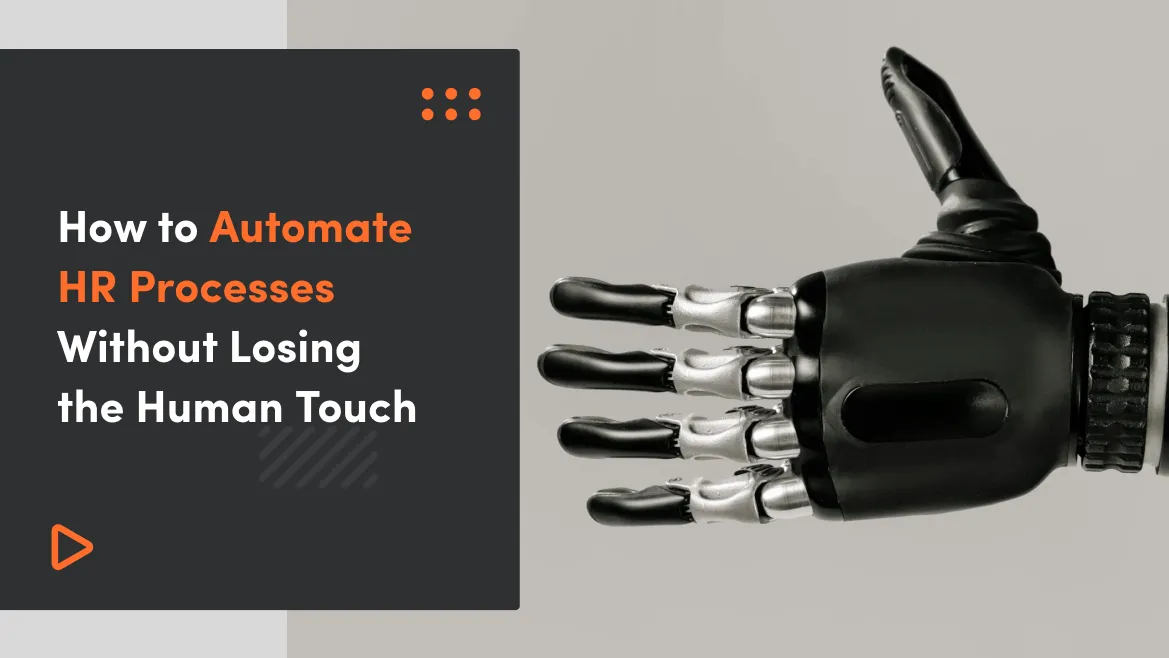Imagine slashing your HR workload by nearly half while simultaneously boosting employee performance and satisfaction.
Sounds impossible?
It's not because it’s it’s entirely achievable with the right HR automation tools!
Let’s be honest, we all love quick wins. But in HR, that’s something you can’t achieve as easily as a lot of manual work needs to be done because every HR operation has a challenge - a race against time.
Is it possible to reduce manual work by 40%?
Thankfully, there’s a solution. Using HR automation tools, the transformation of your daily operations isn’t just a simple promise, it’s an immediate reality that you can feel not just in numbers but also in efficiency.
Routine HR tasks like attendance tracking, payroll processing, and onboarding can be automated, giving your management a chance to lead with flawless precision.
It goes even further, as simple automation isn’t the only goal. Most automation tools are designed to handle complex data analytics, turning large amounts of HR data into actionable insights. This allows you to boost efficiency and enhance learning at the same time, with one common goal: elevating employee performance to a new level.
By utilizing the performance management module, you can quickly identify trends, predict your company's future needs, and make real-time adjustments while minimizing the potential for human error.
But, will it cut the number of people in your HR department?
Not necessarily!
It’s a common misconception that automation will lead to job loss. However, we are focused on HR evolution instead of reduction. By automating routine tasks, we are focused on freeing your HR professionals to focus on more strategic and impactful initiatives that will transform your company in the long term.
Focusing on talent management, employee engagement, and fostering a positive work culture, your company will grow in a more natural and healthier way, providing better employee efficiency and increased income.
How Can HR Automation Tools Help?
Okay, we've set the stage and given you a sneak peek at how your company can grow faster; it’s time to explore which processes feel the impact of automation the most.
From the very beginning of the hiring process to the very end of keeping track of employees' success, you’ll see how good automation tools can change your company's performance!
Recruiting
The first step that needs to be upgraded is recruiting. Because of the competitive nature of today's market, companies receive hundreds, if not thousands, of CVs every day. Sorting through this volume manually is not only time-consuming but also increases the chance of overlooking potential top talent. With the use of sophisticated algorithms to filter and prioritize applications based on the specific needs and criteria of your business, you can quickly identify candidates who meet essential qualifications and rank them according to their suitability for the position.
By doing this, you speed up the hiring process and ensure that you’re always looking at the most qualified applicants on the market.
I just have one quick question for you:
Didn’t you hate it when you sent a CV to a company and they never replied?
That is no longer necessary since automated technologies may be used throughout the recruitment process, beginning with the receipt of the candidate's paperwork and keeping them informed and involved throughout.
You may also quickly arrange interviews depending on the availability of both the candidate and the manager, considerably decreasing administrative workload. This gives you more time to focus on the quality of the interview and ensure that you've recruited the best candidate for the position.
Employee Onboarding
The second crucial upgrade is staff onboarding. Onboarding is more than a procedure - it shapes a new hire's experience. Research shows companies with strong onboarding processes reduce new job turnover by 50% in six months. Automation can make a difference here.
Automated document collection is a game-changer. Online portals allow new recruits to submit ID proofs and background checks during pre-boarding safely, which increases onboarding speed and lowers chances for errors.
Until now, HR departments have traditionally manually created and allocated user accounts and rights, but by using automation, the program can automatically conduct these activities depending on job roles, giving new recruits quick access to all corporate tools and systems.
This way, you make your new hires feel prepared and supported by the company, drastically improving their first impression and lowering turnover. You also eliminate a lot of administrative work and have your employee working in his regular position in no time!
The best part is that you can also use the same software for offboarding tasks like automatic data archiving, access removal, and simplified exit surveys, which helps you upgrade all future onboarding processes.
Paid Leave & Expense Management
Vacations and paid leaves are important for employee satisfaction, but managing them can be one of the most time-consuming parts of human resource management. Still, this can be easily solved with self-service portals that allow your employees to submit leave requests like vacation or sick days directly, which are easily approved upon examination.
You can also handle any documentation through the portals, which reduces the number of email filtering needed to find the right documentation needed.
The same goes for expense management, where employees can capture and submit expense receipts electronically through mobile apps or web portals. Once the claims are approved, the automated reimbursement function allows faster reimbursements without the need to wait for the salary.
Payroll
When we’re talking about salary, HR employees spend most of their regular work day on this, as they depend on multiple inputs, taxes, and laws that regulate their salaries.
The main problem is their deadline, as payroll calculations require high accuracy as fast as possible. By using professional software, it can handle calculations and deductions for taxes, as well as integrate performance metrics to provide accurate salaries and bonuses delivered on time and reduce the workload on HR professionals at the same time.
Employee Performance Tracking
Performance and feedback are often overlooked in companies as there is “never enough time,” but they’re crucial to every project management. Nobody likes those endless paper trails and last-minute scrambles that are written just to have a review right before the deadline, as you usually have an unhappy employee who doesn’t know what he’s doing wrong and a project manager who didn’t solve an issue.
By reminding them on time, you can ensure that everybody knows they need to prepare their reports and make data-driven decisions.
Using automatic time tracking and powerful project management software, managers can monitor team and individual performance, which may sound like micro-management, but in reality, it’s valuable insight.
This way, you can set clear, measurable goals and track progress automatically, allowing your employees to focus more on the work without spending much of their workday on unnecessary reports.
Try our developers.
Free for 2 weeks.
No risk. Just results. Get a feel for our process, speed, and quality — work with our developers for a trial sprint and see why global companies choose Selleo.
Ready-made vs. Custom HR Solutions
Now, the one-million-dollar question is: should you choose the ready-made HR automation tools or invest in a custom solution? Let’s check both options!
First, things first, you get the ready-made HR solutions right away, so you can optimize your processes right away, and you don’t have any opportunity cost. They’re also cost-effective, made to be user-friendly, and designed to cater to most businesses.
The cons?
Well, they’re broad and general, and while they may be great for most businesses, there is always a possibility that there’s that one option that you’re missing to be perfect, and you’ll find yourself customizing your processes to the tool, instead customizing the tool to the process.
Custom options are like a nice suit. Yes, they may cost more, you have to wait a little for them, but when you try them out, they’re perfect! The main difference between ready-made HR tools and custom solutions is that you’re the designer, telling the tailor, or rather the software company, how to make the perfect fit for your processes. This level of integration makes sure that every feature works perfectly with your business needs, which improves both efficiency and the user experience.
So, which one should you choose? For small and medium businesses, ready-made tools are a great choice until they polish their processes and grow to pick their custom solution, made just for them.
For larger companies, custom solutions are the perfect choice from the start, as they offer optimization for specific needs that can't be met by standard tools. It's an investment that not only meets your needs now but also plans for growth and new challenges in the future.
Implementing HR Automation Tools
Implementing HR automation tools in your business or SaaS solutions involves several key steps to ensure a smooth transition and optimal results. Let's walk through these steps together.
Step 1: Identify needs
First, identify your needs. Begin by assessing which HR tasks are the most time-consuming in your organization. This might include payroll processing, applicant tracking, benefits management, or performance reviews. Conducting a thorough analysis will help you pinpoint where automation can have the most significant impact.
Step 2: Choose the right tools
Next, choose the right tools. Selecting the best automation tools for your business requires careful consideration. Look for features such as integration capabilities, user-friendliness, and scalability. It's crucial that the tools you choose can easily integrate with your existing systems and scale as your business grows. User-friendliness ensures that your HR team can quickly adapt to the new system, minimizing the learning curve.
Step 3: Integration
Integration is a critical step in the implementation process. Work with a skilled software development team to seamlessly integrate these tools into your existing systems. This involves setting up the necessary infrastructure, configuring the software to meet your specific needs, and ensuring that all data is accurately transferred. A smooth integration process minimizes disruptions and ensures that your HR team can start benefiting from the new tools as quickly as possible.
Step 4: Training and support
Finally, provide training and support. Ensure your HR team is thoroughly trained to use the new tools effectively. This might involve hands-on training sessions, instructional materials, and ongoing support to address any issues that arise. Continuous support is essential to help your team troubleshoot problems and maximize the benefits of the automation tools."
Conclusions
If you're ready to take your HR department to the next level and want to ensure you're not just keeping up but leading the way in employee management and satisfaction, it’s time to act!
To learn more about our HR automation solutions and how they could especially support your company's growth, be sure to subscribe to our channel and check our links below!
Accompany your HR management revolution and elevate, automate, and invent!




